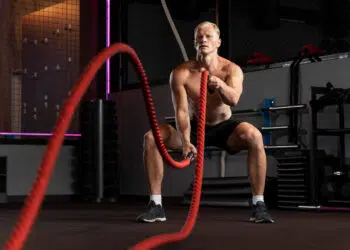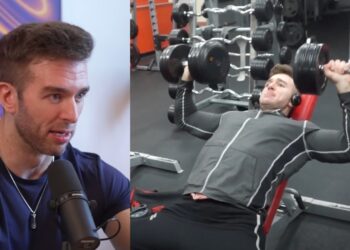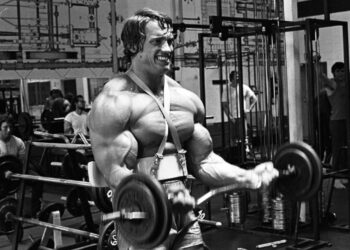Dr. Rhonda Patrick, the co-founder of FoundMyFitness and a devoted cell biologist, is back to break down the complexities of exercise science. In a recent YouTube video, Dr. Patrick discussed the heart benefits of high-intensity interval training, the role of lactate during workouts, glucose control, mitochondrial health in athletes, and reversing the aging process.
Having completed her graduate research at the St. Jude’s Children’s Research Hospital on mitochondrial metabolism, Dr. Rhonda Patrick is uniquely qualified to tackle these nuanced topics. With over 492,000 subscribers on YouTube, Patrick has become a powerful voice not only in the world of biology but online as well.
Appearing on the Joe Rogan Experience and taking part in interviews with Dr. Peter Attia, Rhonda Patrick continues to pursue optimum health and has taken fans on her journey. Improving heart health with exercise has also piqued her interest. This prompted Patrick to shed some light on the inner workings of the human body, especially regarding glucose control, lactate, intense exercise, and mitochondrial vitality for anti-aging efforts.
Dr. Rhonda Patrick Talks HIIT Wokout Benefits and the Role of Lactate During Exercise
With age potentially reducing our exercise capacities, Dr. Rhonda Patrick underlined why vigorous exercise or high-intensity interval training slowed the aging process dramatically in a study featuring 50-year-olds.
Level Up Your Fitness: Join our 💪 strong community in Fitness Volt Newsletter. Get daily inspiration, expert-backed workouts, nutrition tips, the latest in strength sports, and the support you need to reach your goals. Subscribe for free!
“As we age, the heart undergoes specific inevitable changes, right, related to the aging process. So it tends to get smaller, it gets stiffer, and this can impact the heart’s efficiency, potentially reducing our exercise capacity, elevating our risk for cardiac issues but there can be exercise interventions like consistent aerobic exercise with a high proportion of it being vigorous intensity that can actually combat some of these effects.”
“A landmark study it was published by Ben Lavine’s Group, an intervention study and it showed that two years of vigorous exercise in 50-year-olds was able to reverse the aging of their hearts by as much as 20 years. Effectively making their hearts look more like a 30-year-old, which in my opinion is simply astonishing,” explains Dr. Rhonda Patrick.
The exercise protocol used in the study included 5-6 hours a week of ‘maximal steady state intensity exercise.’
“The exercise protocol used in this particular study, it was a protocol that gradually increased the exercise intensity and also frequency. Again, I mentioned it was a two-year intervention, by the end of the first six months, participants were exercising about 5-6 hours a week with a large portion of training being in that maximal steady state intensity exercise, which I referred to earlier in the podcast. It’s often called zone three.”
According to Patrick, HIIT workouts and vigorous exercise have lasting benefits for glucose control and insulin sensitivity.
“Vigorous exercise really shines, particularly high-intensity interval training, it improves glucose control, insulin sensitivity more efficiently, and more potently than even continuous moderate-intensity workouts.”
Next, Patrick explained the role of lactate and how it relates to anaerobic and aerobic activities.
“There’s a demand for rapid energy production so the body relies both on aerobic, so oxygen-using, and anaerobic non-oxygen-using metabolic pathways to generate this energy.
The Anaerobic pathway can lead to the production of lactate, especially when the intensity of exercise surpasses the point at which the oxygen intake can keep up with the energy demand.”
Lactate releases when the exercise surpasses the point at which oxygen intake can keep up with energy demand. Patrick shares why lactate is no longer considered a ‘waste product’ of muscle fatigue.
“This is sometimes often referred to the lactate threshold as we talked about. For a long time, lactate was considered primarily as a waste product contributing to muscle fatigue.”
She underlined that lactate is transported back into the muscle and accumulates at even higher levels in mitochondria, which is known as the lactate shuttle.
“This of course has been completely reversed. Recent research has totally changed this understanding. Lactate generated in muscle tissue is transported not only back in the muscle but into mitochondria to be used as an energy source but it also it starts to accumulate at higher levels it travels systemically into circulation and gets transported to other tissues like the heart, liver, and the brain, where it’s used for energy.”
“This is known as the lactate shuttle, pioneered by Dr. George Brooks.”
Dr. Patrick Discusses Enhancing Glycemic Control and ‘Mitochondrial Biogenesis’
During exercise, Patrick explained that lactate acts as a ‘signaling molecule,’ helping increase the glucose transporters in muscle cells and allowing for efficient glucose uptake into the muscles at rest.
“Vigorous intensity exercise, high-intensity interval training, when that lactate production accumulates, it stimulates the expression and activity of glucose transporters on the muscle known as GLUT4 and this is on the muscle cell membrane. That lactate acts as a signaling molecule to increase the transport of glucose transporters on the muscle cells.”
“This then allows for more efficient uptake of glucose into from the bloodstream into the muscle even at rest.”
Dr. Patrick then examined the relationship between mitochondrial genesis (the production of new healthy mitochondria) and high-intensity interval training/vigorous exercise.
“Talking about mitochondria, mitochondria are very important and they play a lot of roles in the body but one of the most important ones is the production of energy in the form of ATP. This is obviously very important for muscles but also hugely important for the brain, the heart, the liver, pretty much every organ.”
“Athletes are very interested in mitochondrial health because they want their muscles to efficiently and effectively produce energy when they are training but mitochondria are also very important to the context of aging. As we age, our mitochondria become less efficient at producing energy and this poses a problem for physical activity but also just for normal functioning of our organs.”
“That problem of mitochondria not producing enough energy can actually be overcome by increasing the mitochondrial volume or what’s called the mitochondrial biogenesis. An exercise, particularly vigorous exercise is one of the best ways to do that.”
The body’s ability to perform mitochondrial biogenesis is one of the most powerful indicators of mitochondrial health.
“One of the most powerful indicators of healthy mitochondria is the ability to generate new healthy young mitochondria called mitochondrial biogenesis.
Vigorous intensity exercise like high-intensity-interval training I mentioned it’s one of the most powerful stimulators of mitochondrial biogenesis. This has to do with the metabolic stress that is induced from vigorous intensity exercise.”
Upon performing vigorous exercise or HIIT, the lactate is shuttled to the mitochondria, which ultimately prompts biogenesis and its ability to be used as energy.
“When we perform vigorous intensity exercise such as HIIT, that lactate generated from the muscles it’s shuttled into the mitochondria because exercise increases the number of mitochondria per cell, again mitochondrial biogenesis and the more lactate that’s then able to be used as energy.”
Dr. Rhonda Patrick isn’t the only high-profile proponent of the benefits drawn from HIIT workouts. Bodybuilding icon and former six-time Mr. Olympia Dorian Yates was celebrated for his ‘Blood and Guts HIIT workouts,‘ where he routinely went to failure instead of focusing on a set number of reps or sets.
Given the complexity of these topics, Dr. Rhonda Patrick serves as a great source of knowledge for the fitness and bodybuilding community. Her insights into glucose control, mitochondrial health, and lactate present a more than compelling case for the benefits of HIIT workouts or vigorous exercise.
RELATED: The Critical Role of Mitochondria for Building Muscle and Burning Fat










Hello,
Suggest defining what HIIT is in terms of heart beat and age, rest and work periods or sprints?
Thank you!
Hello Marty,
Thank you for your comment. High-Intensity Interval Training (HIIT) is a form of cardiovascular exercise that alternates between short bursts of intense activity and periods of less intense activity or rest. The specifics of HIIT can vary, but generally, the intense periods are performed at a heart rate close to your maximum, which can be estimated by subtracting your age from 220.
For example, a 40-year-old would have a maximum heart rate of about 180 beats per minute (220-40=180). The duration and intensity of the work and rest periods can vary based on your fitness level and the goals of the workout.
Common ratios of work to rest are 1:1 or 1:2. Always consult with a healthcare provider before starting any new exercise regimen, especially if you have any health concerns.
You can learn more on HIIT here: https://fitnessvolt.com/hiit-for-beginners/
Great Article Doug, and I love this gal’s videos, I watch them all. She’s right. At age 60 (trail runner) I can attest to the benefits. Great research and information here.